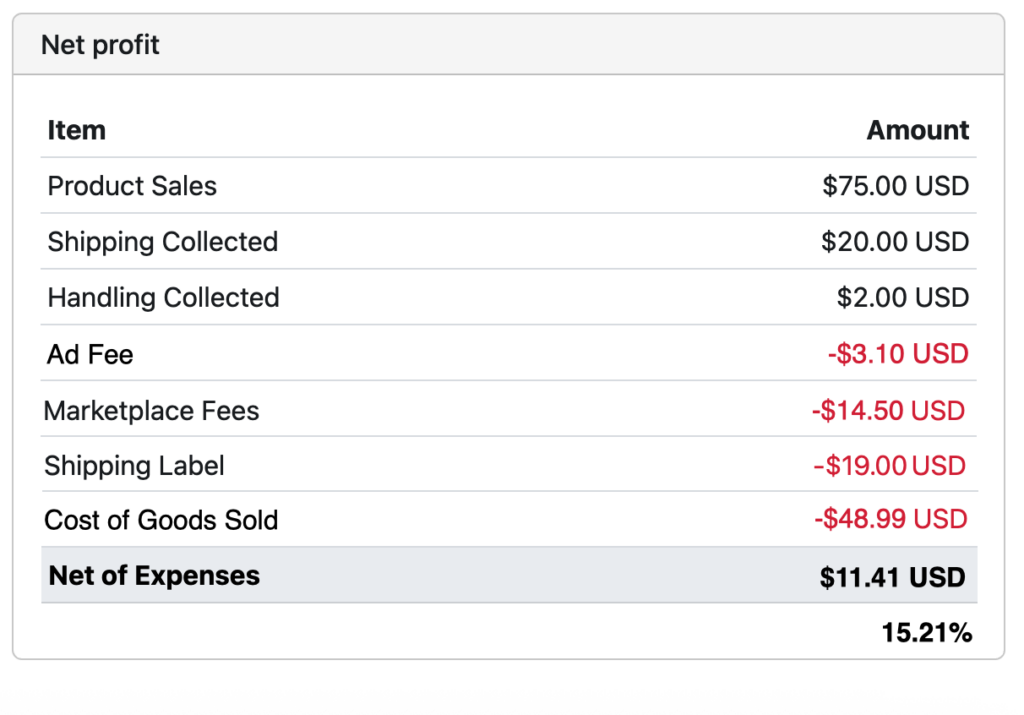View your eBay profit per order
It is with no small sense of excitement that we are announcing the initial rollout of a long-awaited feature: the ability to view your NET profit per order. What is net profit per order? It’s how much money you make after all order-level costs have been factored in, including inventory cost, fees and shipping. Many customers think of it as their “ROI” or return on investment for each item they sell.
This has been a goal going back to the original days of Outright, which became GoDaddy Bookkeeping, which was eventually shut down – all without ever having delivered on one of the most powerful features available in eCommerce: the ability to answer the question – how much money did I actually make on that sale?
What’s new?
If you have followed along, we announced a while back the ability to see your Gross Profit on both a per-order basis and on a per-product basis. This was a great starting point for those sellers who track inventory costs at the item level.
But what about the other costs associated with an order, like fees and shipping costs?
That’s where our new update comes in. With many platforms, we receive enough information about order-related fees to automatically link those additional expenses.
eBay profit per order
To start, we have rolled this functionality out for eBay sellers. In addition to Final Value fees, we can now also get your shipping label expenses and any Ad fees for that order. Assuming you have also recorded your inventory costs and use the Custom label (SKU) field when listing, Seller Ledger can now give you the following:

Just click into your eBay account, and, next to any order, click “>>expand” to see this new breakdown.
What if I buy shipping elsewhere?
Fear not, we also have the ability for you to link purchases of shipping labels/postage from other sources (e.g. Shipstation, Pirate Ship, USPS, FedEx, wherever.) In those case, you’ll see a line that looks like this:

Click that button to choose from an existing purchase from one of your connected bank/credit card accounts, or to manually enter the shipping cost:

A few caveats
As with any software solution, we can only provide information that is as good as the data we receive. If you don’t track your inventory costs at the item level, we cannot, of course, tell you your net profit.
For inventory item costs, even if you don’t track using unique SKUs that tie to your sold items, we do offer the ability to add per-sale item cost information after the fact.
In addition, for sellers on other marketplaces/platforms, you may notice pieces of this functionality when you click on >>expand in those accounts, but not as complete. Fear not, it’s on our list to expand to other direct connections such as Amazon, Shopify, Etsy and Walmart.
Help us continue to journey
We have made great strides in providing you the information you need to see how much money you are making on each eCommerce sale. But as you can see, there’s still more work to do. We will continue to automate more matching of information that is currently available. But to achieve more automation, we could use your help.
For those marketplaces that don’t provide public APIs of their financial data (Poshmark, Mercari, Whatnot, Depop,) we invite you to email them and make that request. If enough people do so, perhaps they will prioritize such an effort. And if they do, rest assured, Seller Ledger will be here to add that next level of automation and insight.
Are you using a less automated way to manage your eCommerce finances?
Whether it’s manual spreadsheets or other accounting platforms that don’t provide enough detail, it’s never too late to improve your back office processes. We let our product speak for itself, which is why we offer everyone a 30-day free trial, with no credit card required. Sign up and connect multiple platforms in minutes.
